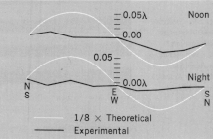The Michelson-Morley
Experiment
In 1881, Albert A. Michelson did an experiment to try to detect a
difference in the speed of light in two different directions: parallel
to, and perpendicular to, the motion of the Earth around the Sun. Much
to his dismay, he found no difference. According to the ether
hypothesis, light the speed of light depends on the velocity of the
apparatus relative to the ether.
In 1887, he repeated the measurement with Edward Morley. The results
of their measurements are shown below. As they turned their apparatus,
there was no measurable difference between the speed of light in the
two directions: at most 1/40 of the expected amount. Later workers
improved the accuracy of the measurement by about another factor of
ten.

Michelson and Morley's results from A. A. Michelson, Studies in
Optics
(Univ. of Chicago Press, Chicago, 1962)

Interference "fringes" showing no change as the interferometer is
rotated.
(G. Joos, Lehrbuch der Theoretischen Physik, Akademische
Verlags.,
Leipzig, 1930)
The table shows a selection of measurements over a fifty year span.
The observed fringe shift is the upper limit estimated by the
experimenter. The ratio to the calculated value is the ratio of
the observed shift to the value predicted by the ether hypothesis,
assuming a motion of the Earth through the ether equal to the orbital
speed of the Earth.
|
experimenter
|
year
|
observed fringe shift |
ratio to calculated value |
| Michelson |
1881 |
0.02 |
0.5 |
| Michelson & Morley |
1887 |
0.01 |
0.02 |
| Morley & Miller |
1904 |
0.015 |
0.01 |
| Miller |
1926 |
0.08 |
0.07 |
| Kennedy |
1926 |
0.002 |
0.03 |
| Illingsworth |
1927 |
0.0004 |
0.006 |
| Joos |
1930 |
0.002 |
0.003 |
The null results obtained by Michelson and subsequent experimenters
showed that the ether hypothesis was incorrect. The speed of light did
not depend on the motion of the source, as had been widely assumed. The
special theory of relativity, with its counter-intuitive hypothesis
that
the speed of light is the same in all inertial frames, stepped in to
reconcile the results of the Michelson-Morley experiment with the rest
of physics.
Michelson received the Nobel Prize in 1907 for his work, the first
American to receive the Prize in science. Find out more about the Michelson-Morley
experiment at the American Institute of Physics website.
Return to the
Syllabus.
 Return
to the home page.
Return
to the home page.
This page is copyright ©1997-2007 by G. G.
Lombardi. All
rights reserved.